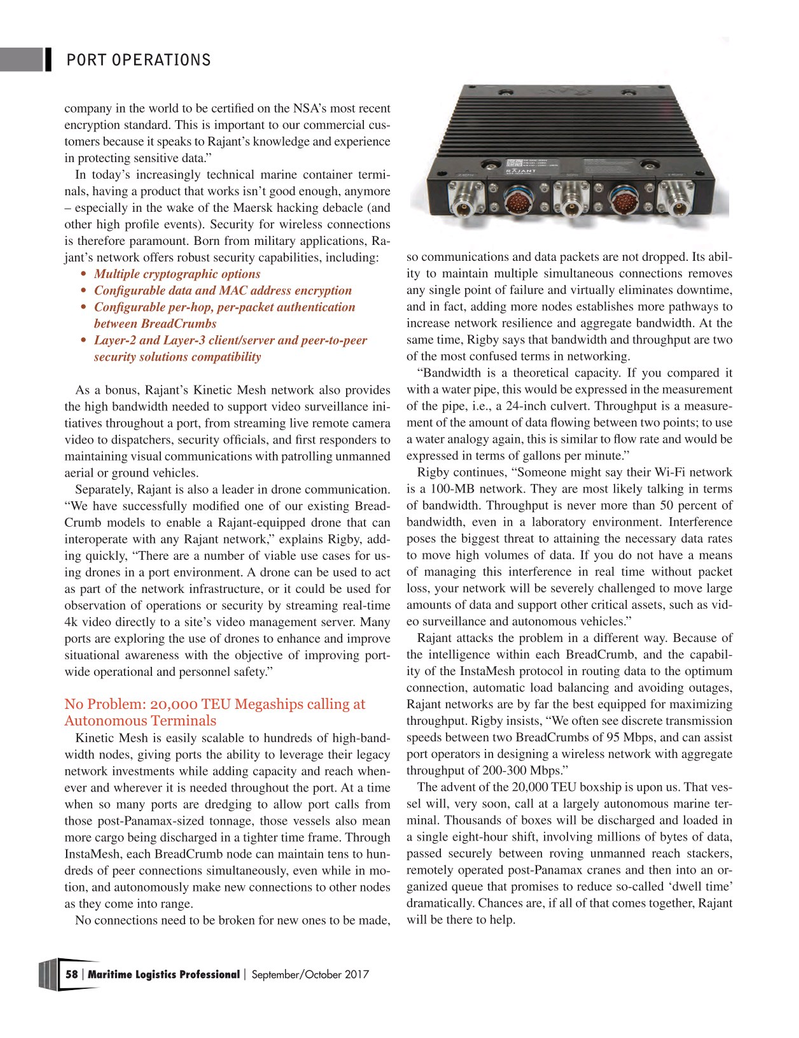
Page 58: of Maritime Logistics Professional Magazine (Sep/Oct 2017)
CONTAINER PORTS
Read this page in Pdf, Flash or Html5 edition of Sep/Oct 2017 Maritime Logistics Professional Magazine
PORT OPERATIONS company in the world to be certifed on the NSA’s most recent encryption standard. This is important to our commercial cus- tomers because it speaks to Rajant’s knowledge and experience in protecting sensitive data.”
In today’s increasingly technical marine container termi- nals, having a product that works isn’t good enough, anymore – especially in the wake of the Maersk hacking debacle (and other high profle events). Security for wireless connections is therefore paramount. Born from military applications, Ra- jant’s network offers robust security capabilities, including: so communications and data packets are not dropped. Its abil- • Multiple cryptographic options ity to maintain multiple simultaneous connections removes • Confgurable data and MAC address encryption any single point of failure and virtually eliminates downtime, • Confgurable per-hop, per-packet authentication and in fact, adding more nodes establishes more pathways to between BreadCrumbs increase network resilience and aggregate bandwidth. At the • Layer-2 and Layer-3 client/server and peer-to-peer same time, Rigby says that bandwidth and throughput are two security solutions compatibility of the most confused terms in networking.
“Bandwidth is a theoretical capacity. If you compared it
As a bonus, Rajant’s Kinetic Mesh network also provides with a water pipe, this would be expressed in the measurement the high bandwidth needed to support video surveillance ini- of the pipe, i.e., a 24-inch culvert. Throughput is a measure- tiatives throughout a port, from streaming live remote camera ment of the amount of data fowing between two points; to use video to dispatchers, security offcials, and frst responders to a water analogy again, this is similar to fow rate and would be maintaining visual communications with patrolling unmanned expressed in terms of gallons per minute.” aerial or ground vehicles. Rigby continues, “Someone might say their Wi-Fi network
Separately, Rajant is also a leader in drone communication. is a 100-MB network. They are most likely talking in terms “We have successfully modifed one of our existing Bread- of bandwidth. Throughput is never more than 50 percent of
Crumb models to enable a Rajant-equipped drone that can bandwidth, even in a laboratory environment. Interference interoperate with any Rajant network,” explains Rigby, add- poses the biggest threat to attaining the necessary data rates ing quickly, “There are a number of viable use cases for us- to move high volumes of data. If you do not have a means ing drones in a port environment. A drone can be used to act of managing this interference in real time without packet as part of the network infrastructure, or it could be used for loss, your network will be severely challenged to move large observation of operations or security by streaming real-time amounts of data and support other critical assets, such as vid- 4k video directly to a site’s video management server. Many eo surveillance and autonomous vehicles.” ports are exploring the use of drones to enhance and improve Rajant attacks the problem in a different way. Because of situational awareness with the objective of improving port- the intelligence within each BreadCrumb, and the capabil- wide operational and personnel safety.” ity of the InstaMesh protocol in routing data to the optimum connection, automatic load balancing and avoiding outages,
Rajant networks are by far the best equipped for maximizing
No Problem: 20,000 TEU Megaships calling at throughput. Rigby insists, “We often see discrete transmission
Autonomous Terminals
Kinetic Mesh is easily scalable to hundreds of high-band- speeds between two BreadCrumbs of 95 Mbps, and can assist width nodes, giving ports the ability to leverage their legacy port operators in designing a wireless network with aggregate network investments while adding capacity and reach when- throughput of 200-300 Mbps.” ever and wherever it is needed throughout the port. At a time The advent of the 20,000 TEU boxship is upon us. That ves- when so many ports are dredging to allow port calls from sel will, very soon, call at a largely autonomous marine ter- those post-Panamax-sized tonnage, those vessels also mean minal. Thousands of boxes will be discharged and loaded in more cargo being discharged in a tighter time frame. Through a single eight-hour shift, involving millions of bytes of data,
InstaMesh, each BreadCrumb node can maintain tens to hun- passed securely between roving unmanned reach stackers, dreds of peer connections simultaneously, even while in mo- remotely operated post-Panamax cranes and then into an or- tion, and autonomously make new connections to other nodes ganized queue that promises to reduce so-called ‘dwell time’ as they come into range. dramatically. Chances are, if all of that comes together, Rajant
No connections need to be broken for new ones to be made, will be there to help. 58 Maritime Logistics Professional September/October 2017 | |

 57
57

 59
59
